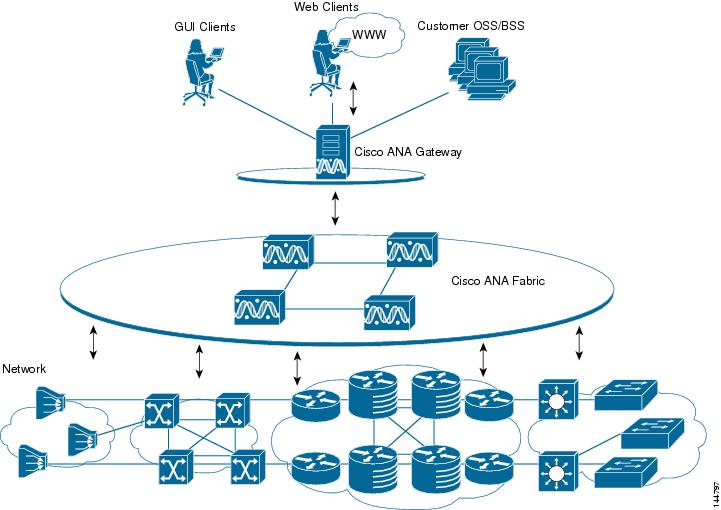
Cisco Active Network Abstraction High Availability User Guide, 3.6
Cisco ANA Architecture

Table Of Contents
Cisco ANA Architecture
This chapter briefly describes the Cisco Active Network Abstraction (ANA) platform's three layer architecture comprising the Cisco ANA Gateway and Cisco ANA fabric, introducing Cisco ANA Units as a prelude to describing the Cisco ANA high availability functionality.
Architecture
The Cisco ANA platform architectural diagram and functional blocks are displayed below:
Figure 1-1 Cisco ANA Architecture
The top layer is comprised of the commercial and/or legacy OSS/BSS applications, as well as the Cisco ANA Client application suite. The Cisco ANA solution enables OSS/BSS applications to integrate with the platform, via a set of well-defined standards based APIs.
The second layer is comprised of the gateway, through which all the OSS/BSS applications and our clients access the Cisco ANA fabric. Each client connects to its designated gateway server.
The third layer is comprised of the interconnected fabric of units, each managing a subset of the Network Elements (NE) in the network. The units are distributed in a way that ensures proximity to their NEs.
Cisco ANA Gateway
The gateway serves as the gateway through which all clients, including any OSS/BSS applications as well as the clients access the system. It enforces access control and security for all connections and manages client sessions. In addition it maintains a repository for keeping system settings, topological data and snapshots of active alarms and events.
Another important function of the gateway is to map network resources to the business context. This enables Cisco ANA to contain information that is not directly contained in the network (such as VPNs and subscribers) and display it to northbound applications. In addition, the gateway contains the alarms and events in the system.
Cisco ANA Units
The main purpose of the units is to host the autonomous Virtual Network Elements (VNEs). The units are interconnected to form a fabric of VNEs, which can inter-communicate with other VNEs regardless of which unit they are running on. Each unit can host thousands of autonomous VNE processes (depending on the server system size and VNE type). The units also allow for optimal VNE distribution, ensuring geographic proximity between the VNE and its managed NE.
Cisco ANA Clients
Cisco ANA provides a comprehensive suite of GUI applications to manage the network using the Cisco ANA platform.
•
Cisco ANA NetworkVision—The main GUI application of Cisco ANA, used to visualize every management function supported by the system. For more information see the Cisco Active Network Abstraction NetworkVision User Guide.
•
Cisco ANA EventVision—A tool for viewing all historical events detected by the Cisco ANA system. For more information see the Cisco Active Network Abstraction EventVision User Guide.
•
Cisco ANA Manage—System administration and configuration tool for managing the entire Cisco ANA platform. For more information see the Cisco Active Network Abstraction Administrator Guide.

 Feedback
Feedback